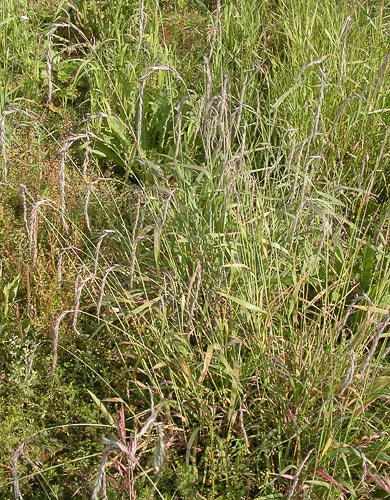Relatives
Elymus sibiricus L. - Siberian wild rye.
Taxonomic position.
Family Poaceae Barnhart., genus Elymus L.Synonyms.
Clinelymus sibiricus (L.J.) Nevski., Elymus tener L., Elymus praetevisus Steud., Hordeum sibiricum (L.) Schenk, Elymus Krascheninnikovii Roshev., Triticum arctasianum Hermann., Elymus pendulosus Hodgson.Biology and morphology.
Perennial herb. Root system is well-developed and forms sod. Stems grow up to (30)40-100(140) cm high, erect, more rarely genuflexed at the base, rather thick, uniformly leafed. Sheathes glabrous, sometimes pubescent, at the lower leaves. Leaf blades up to 15 mm wide, flat and glabrous or sometimes pubescent on the upper surface. Spike laxiflorous nutant with spikelets arranged in pairs, greenish or violet, up to 23 cm long. Spikelets 1.3-1.5 cm long. Glume 4.0-5.5 mm long; lower glume is half the length of the lemma, lanceolate with 1-3 ribs, tapering into an awn 1.0-5.0 mm long. Lemma 8.0-11.0 mm long with 5 ribs, lanceolate, almost glabrous or setaceous with awn 15.0-25.0 mm long deflexed to the side. Upper lemma is equal in size to lower. Anthers 1.0-1.7 mm long. Blossoms in June; seeds ripen in August. Cross-pollinated by wind. 2n = 28, 42.Distribution.
Occurs throughout the European region of the former USSR (the northern part of the Southern Urals), Central Asia (mountainous areas), Siberia (except the Arctic), and the Far East.Ecology.
Meso-xerophyte, adapted to temperate regions. Occurs in dry meadows, on stony slopes, among bushes, in forests, and along rivers in sands as high as the middle mountain level. Resistant to drought; very cold-resistant and frost-resistant. Resistant to early fall and late spring frosts.Utilization and economic value.
Valuable forage and pasture species for areas with severe winters. Does not tolerate shade. Can be used for hay, haylage. Good palatability. Improves soil structure and fertilization. Used for erosion control. Cultivated in Siberia.Literature cited:
Brezhnev D.D., Korovina O.N. 1980. Wild relatives of the cultivated plants of flora of the USSR. L.: Kolos, 376 pp. (in Russian).Fedorov A.A., ed. 1974. Flora of the European USSR. Vol. 1. L.: Nauka, 404 pp. (in Russian).
Harkevich S.S., ed. 1985. Vascular Plants of the Soviet Far East. Vol. 1. St. Petersburg: Nauka, 390 p. (in Russian).
Harkevich S.S., ed. 1982. Wild fodder grasses of Fast East. Moscow: Nauka, 240 pp. (in Russian).
Kovalevskaja S.S., ed. 1968. Central Asian Flora. Vol. 1. Taschkent: Uzbekistan SSR, 226 pp. (in Russian).
Malyshev L.I., Peshkova G.A., eds. 1990. Flora of Siberia. Vol. 2. Novosibirsk: Nauka, 361 pp. (in Russian).
Rodjevitz P.U., Schischkin V.K., eds. 1937. Flora of the USSR. Vol. 2. M.-L.: USSR, 778 pp. (in Russian).
Shishkin B.K., ed. 1950. Flora of Kirghizia. Vol. 2. Frunze: Kirghizia SSR, 315 pp. (in Russian).
Tzvelev N.N. 1976. Poaceae USSR. L.: Nauka, 788 pp. (in Russian).


